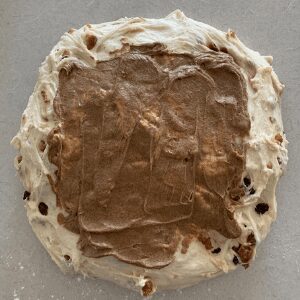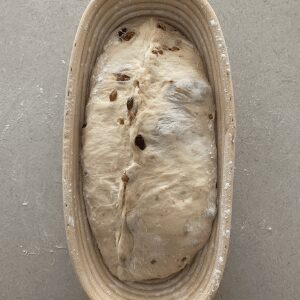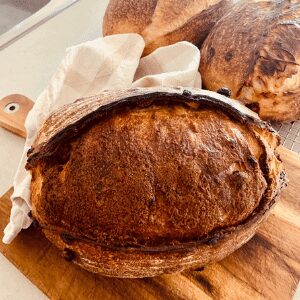
Sourdough Fruit Bread Recipe with Cinnamon {plus variations}
This easy fruit loaf laced with cinnamon is the only sourdough fruit bread recipe you'll ever need. With loads of recipe variations, there's sure to be a version that has your tastebuds tingling.
Servings 1 Loaf
Calories 2657kcal
Equipment
- Mixing Bowl
- Digital Scales
- Banneton
- Dutch Oven
Ingredients
- 500 g Bread Flour
- 350 g Water
- 100 g Sourdough Starter fed and bubbly (see levain alternative in notes)
- 10 g Salt
- 30 g Honey
- 100 g Mixed Dried Fruit
Cinnamon Filling
- 40 g Butter
- 10 g Cinnamon
- 30 g All Purpose Flour
Instructions
- Autolyse:Weigh out your starter, water and honey in a glass or ceramic bowl. Mix them together so that the honey is dissolved in the water (or at least really well distributed).Then add your flour and salt and mix altogether with the end of a wooden spoon. The dough will be fairly shaggy and only just brought together.Cover your bowl with cling film or a damp tea towel and let it sit for around 1 hour.
- Forming Up Your Dough:Work your way around the bowl, grabbing the dough from the outside, stretching it up and over itself until a smooth ball is formed. You shouldn't need more than about 20-25 folds to form the ball.Once the dough has formed into a smooth ball, pop the cling film back on and let it rest for 30 minutes.
- Stretch & Fold / Adding the Fruit:You need to add the dried fruit to your dough during the stretch and fold phase. It's very easy to do! Try to add the fruit around the second or third set of stretch and folds. So do your first set of stretch and folds with the dough as is and then add the fruit on the second (or third) set depending on how your dough is behaving. Try to do around 4 sets of stretch and folds with around 15 to 30 minutes between each set.
- Bulk Ferment:Once you've finished your stretch and folds, place the cling film or damp tea towel back over your dough and let it rest and ferment. See notes below.
- Shaping Your Dough:Once your dough has finished its first ferment, it's time to give it some shape and surface tension. This loaf is a little different in that you will now add some cinnamon to the dough before you shape it. I think this recipe lends itself to a batard however it's completely up to you what shape you would like.Before you shape your dough - mix the butter, cinnamon and all purpose flour into a paste. Set aside.Ease your dough out of the bowl with the smooth side on the counter and the sticky side up. Pull it into a loose rectangle and spread with the butter and cinnamon mixture. Be careful to leave a border around the edges so that when you shape it the cinnamon is contained and does not leak out of the dough.Once you have shaped your loaf, make sure you tension the dough tightly to ensure that the cinnamon does not leak out. Place it into a floured banneton.If you need help with shaping, you'll find instructions for a batard here and boule here.

- Cold Ferment:Now your dough is in it's "shaping container" cover it loosely with a plastic bag or damp tea towel and place into the fridge. I use a large plastic bag to cover it - I just reuse it each time.Try to leave it in the fridge for a minimum 5 hours up to a maximum of around 36 hours. The longer you leave it the better your bread will be! A longer cold ferment creates beautiful blisters on your crust and a deeper sourdough flavour.

- Preparing To Bake:Once you're ready to bake your sourdough, you'll need to preheat your oven to 230C/450F. Place your Dutch Oven into the oven when you turn it on so it gets hot. Try to preheat for around 1 hour to ensure your oven is super hot - but you know your oven so just adjust this time if you need to.Leave your dough in the fridge until the very last minute - placing a cold dough into a hot oven will give you a great "spring".
- Time to Bake!When your oven is at temperature. Take your sourdough out of the fridge. Gently place it onto a piece of baking paper.Gently score your bread with a lame, clean razor blade or knife - a single slash or cross is perfect for this loaf.Carefully take your dutch oven out of the oven. Place the sourdough into the pot using the baking paper as a handle. Put the lid on and place into the hot oven. If you want to you can spritz your dough with extra water before you put the lid on.BAKE TIME:30 Minutes with the lid on at 230C/450F plus10-15 Minutes with the lid off at 210C/410F
- Finishing The Bake:When you remove your dough from the oven, carefully remove it from the dutch oven as soon as possible and place on a wire rack to cool.

Notes
- Notes on Sourdough Starter
This recipe is based on you having an active starter that you have fed a few hours before starting your bake. For information on whether your starter is ready, go here.
- Notes on Stretch & Folds
If you are going to do the stretch & folds on your bench top, spray your surface with water mist rather than using flour.
- Notes on Bulk Fermentation:
If your home is warm then your dough will ferment a lot faster and could be done in as little as a few hours. If it's colder, it will take longer, possibly overnight. I would recommend that you try to do your first few bulk ferments during daylight hours so that you can watch your dough closely.
Once you're more familiar with the process - and the temperature of your home - you will be able to do overnight ferments.
You will know your dough is ready to move to the next stage when it has *just* doubled in size. It will be fairly wobbly and full of bubbles. You should be able to see large air bubbles under the surface of the dough.
You don't want to let it go any further than doubled as it will be over fermented. If you want to do an overnight ferment, but your home is warm, consider using a little less starter (ie 25g).
Less starter means your dough will take longer to ferment and you will reduce the risk of over fermenting your dough. You'll find more information on these topics here:
When is my bulk ferment finished? What is the difference between cold ferment and bulk ferment? Why does the amount of starter matter?
- Notes on Baking
If you're worried about the base of your bread burning, place a baking sheet on shelf underneath your Dutch Oven - it works! If you're worried about your bread not being cooked all the way through, turn the oven off and place your dough straight onto the oven rack. Leave the door ajar and let your bread rest there for a few hours. Remember not to cut into your loaf too soon - you'll need to let it cool for at least a few hours (4-6 is best).
Nutrition
Calories: 2657kcal | Carbohydrates: 501g | Protein: 70g | Fat: 42g | Saturated Fat: 22g | Trans Fat: 1g | Cholesterol: 86mg | Sodium: 4203mg | Potassium: 1281mg | Fiber: 29g | Sugar: 74g | Vitamin A: 1049IU | Vitamin C: 2mg | Calcium: 366mg | Iron: 9mg